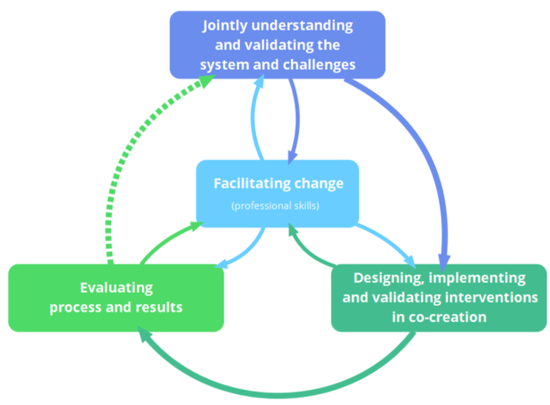LC 00140: verschil tussen versies
Geen bewerkingssamenvatting |
Geen bewerkingssamenvatting |
||
| Regel 57: | Regel 57: | ||
|Toppage=Other | |Toppage=Other | ||
|Sequence number=300000 | |Sequence number=300000 | ||
|Sequence numbers=; | |Sequence numbers=undefined,undefined; | ||
|Context type=Situation | |Context type=Situation | ||
|Heading=About Living Labs | |Heading=About Living Labs | ||
Versie van 30 sep 2021 11:00
Definition and requirements
[ Definition ]
A Living Lab is a concrete user-centered, open-innovation and research setting in which stakeholders with different backgrounds, interests, views and expertise interdisciplinary and through dialogue continuously collaborate and jointly learn (they co-create, or even "co-evolve") to create movement and adaptively find desired and sustainable improvements for complex, social challenges.
[ Requirements of working and learning in Living Labs ]
There is a program of societal challenges (e.g. a research program) that is being worked on in Living Labs. In a Living Lab stakeholders approach the challenge from a systems thinking perspective (see figure 1). They can try to understand what is at stake, they can formulate a shared goal to improve the challenging situation, they can and determine the boundaries of the Living Lab: what is and is not included in it, and why? Stakeholders can reflect critically on the content and process of the challenge itself, the "group learning" process and the individual role. This leads to validated awareness of the challenge.
In a Living Lab stakeholders can jointly and continuously search for widely supported and sustainable improvements, in which the stakeholders take both their joint and individual responsibilities and play their own, specific roles. This leads to trust and connection.
In a Living Lab there is no such construction of client-contractor. Students are future Facilitators of Change - our future colleagues. They can take their role in the form of master-apprentice.
Lessons learned are shared, and ideally are added to a Body of Knowledge and Skills.
Describing Living Labs for the participation of students
[ Summary ]
- Title of the Living Lab
- Aim, short description of the Living Lab and link with societal challenges or transitions
- Description of stakeholders and / or organizations involved
[ What's in it for students? ]
- Activities students will play a role in
- (If relevant) Results to be developed
- Skills that can be developed or learning goals that can be achieved in this Living Lab
- This Living Lab is suitable for students with an expertise / field of interests or study programs in: ...
- Desired or required knowledge and skills
- By whom students will be supervised
- How students will be supervised
- (If relevant) References & starting documents
[ Practical information ]
- Start (date or semester) and duration
- Level (bachelor, master, etc.)
- Preferred or maximum amount of students that can participate
- Language
- (If relevant) Credits (ECTS)
- (If relevant) Minimum grade
- How to sign up / apply
- Registration deadline
- Contact person(s)
[ Additional criteria of Living Labs for MRDD ]
- Assignments at master level
- Linked with transitions / change processes
- Linked with learning goals of the master
- Willingness of partners for student participation / interventions
- Student assignments match with project deliverables
- Preferably long term projects
- Relevant data in English
- Transferability with other deltas
Further reading
- European Network of Living Labs: ENoLL
- Intercultureel werken in Living Labs
- Handreiking innovatiewerkplaatsen
- Co-creation in living labs (article, in Dutch)

